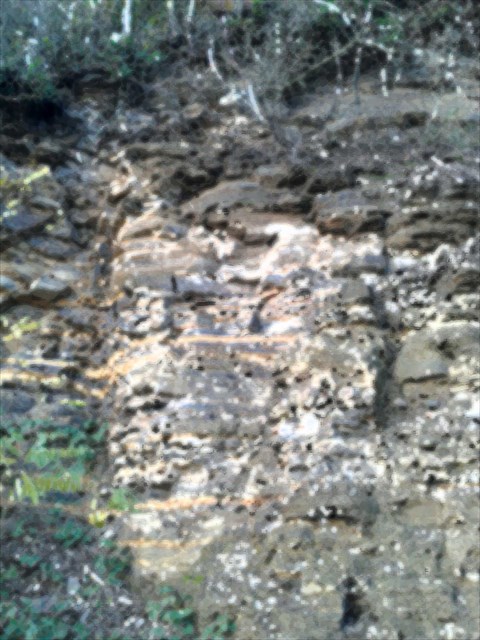 German:
German:
Die frühe Permzeit wird wegen der auffällig rotgefärbten Gesteine aus diesem Zeitabschnitt in Mitteleuropa auch als Rotliegendzeit bezeichnet. Ablagerungen aus dieser Zeit treten beispielsweise auf der linken Rheinseite bei Nierstein und Nackenheim unweit von Mainz und örtlich im Saar-Nahe-Gebiet besonders deutlich zutage. Bei der "Rehborn-Bank" handelt es sich um eine mehrere Meter mächtige Seeablagerung aus der Zeit des unteren Perm, dem Rotliegenden. Dieses Erdzeitalter tritt weltweit nur in unserer Region zwischen Bad Kreuznach und Kusel sowie in Japan stellenweise ans Tageslicht. Die "Rehborn-Bank" bildet darin als buchstäblich steinalte Meeresuntiefe wieder eine Besonderheit.
Das Amphibium Micromelerpeton credneri war einer der Urlurche, die während der frühen Permzeit vor etwa 290 bis 260 Millionen Jahren in den damaligen Seen von Südwestdeutschland lebten. Fossilien dieser Art kamen bisher nur im Saar-Nahe-Gebiet zum Vorschein. Bekannte Fundorte sind die Umgebung von Langenthal an der Nahe, Odernheim am Glan, Rehborn am Glan und Gundersweiler. Möglicherweise existierte die Art auch in Autun in Frankreich.
Die Rotliegendzeit wird in zwei Abschnitte geteilt: Das Unterrotliegende und das Oberrotliegende. Im Unterrotliegenden war das Klima in Deutschland noch verhältnismäßig feucht und sehr warm. Damals herrschten also ideale Lebensverhältnisse für Amphibien, die sowohl im Wasser als auch an Land leben. Der damalige Äquator befand sich etwa auf der Höhe von Basel.
Im Oberrotliegenden wurde das Klima merklich trockener. Ehedem ausgedehnte Seen verlandeten oder trockneten aus. Tümpel und kleine Seen entstanden nur noch kurzfristig. Häufig versiegten die Flüsse. Die zu Beginn des Rotliegenden ausgedehnten Farnwälder waren nur noch auf die unmittelbare Nähe der Flüsse und kurzlebigen Seen beschränkt.
Das Perm endet mit einem gewaltigen Massensterben. Goniatiten, Trilobiten, Eurypteriden und Rugosa sterben aus.
 » Der Cache «
» Der Cache «
Um diesen Earthcache loggen zu können, müssen die folgenden Fragen beantwortet werden:
1.
Vor vielen Millionen Jahren hättest du hier auf einer ... gestanden.
2.
Schätze die Höhe der Wand, vor der du stehst.
3.
Leider ist das Foto etwas unscharf geworden.
Beschreibe deshalb mit deinen Worten das Aussehen dieser geologischen Besonderheit (Material, Farben, Form, Struktur usw.) und was für dich besonders auffällig ist.
Ihr braucht nun nicht auf die Logfreigabe zu warten, sondern könnt sofort loggen. Ich werde mich bei euch melden, wenn etwas nicht stimmt.
Eure Antworten schickt ihr bitte über die Mailadresse in meinem Profil.
Logeinträge ohne zugesendete Antworten werden gelöscht!
Viel Erfolg wünscht Tofino!
~~~~~~~~~~~~~~~~~~~~~~~~~~~~~~~~~~~~~~~~~~~~~~~~~~~~~~~~~~~~~~~~~~~~~~
~~~~~~~~~~~~~~~~~~~~~~~~~~~~~~~~~~~~~~~~~~~~~~~~~~~~~~~~~~~~~~~~~~~~~~
~~~~~~~~~~~~~~~~~~~~~~~~~~~~~~~~~~~~~~~~~~~~~~~~~~~~~~~~~~~~~~~~~~~~~~
 English:
English:
The early Perm time is called also "Rotliegend" because of the conspicuously red-coloured rocks from this period in Central Europe. Depositions from this time you can find for example on the left side of the Rhine close to Nierstein and Nackenheim not far from Mainz and locally in the area close to Saar and Nahe.
The Rehborn Bank is a marine deposit originated in lower Perm. It has a thickness of several meters. This periods deposits are in-situ worldwide only here between Bad Kreuznach and Kusel in Europe and in Japan. The Rehborn Bank is an ancient sand bank that has been transformed into stone.
The amphibian "Micromelerpeton credneri" was one of the old amphibians who lived during the early Perm time before from about 290 to 260 million years in the lakes at that time in South-West-Germany. Fossils of this kind appeared up to now only in the area close to the Saar. Places of discovery are the surroundings of Langenthal/Nahe, Odernheim/Glan, Rehborn/Glan and Gundersweiler. Maybe this kind possibly also existed in Autun in France.
The "Rotliegend"-time is divided into two segments: The lower and the higher period. In the lower period the climate was still relatively humid in Germany and very warm. At that time ideal living conditions ruled for the amphibians who live in the water as well as in country. The equator at that time was possibly on the same latitude as Basel.
In the higher period the climate became noticeably drier. Formerly vast lakes dried up. Only short notice pools and small lakes originated. Often the rivers dried up. The fern woods vast at the beginning of the "Rotliegend" were limited only to the immediate nearness of the rivers and short-lived lakes.
The Permian ended with a huge mass extinction. Goniatites, trilobites, and Eurypteriden Rugosa dying out.
 »The Cache «
»The Cache «
To log this cache, you have to answer the following questions:
1.
Many millions of years ago you would have stood here on a ... .
2.
Estimate the height of the wall you are standing in front of.
3.
Unfortunately the photo is a bit blurred.
Describe with your words the appearance of this geological peculiarity (material, colours, shape, structure etc.) and what is particularly striking for you.
Now you don't need to wait for the log permission, you can log this Earthcache immediately. I'll contact you when something is wrong.
Please send your answers via the mail address in my profile.
Logs without answers will be deleted!
Good luck wishes Tofino!